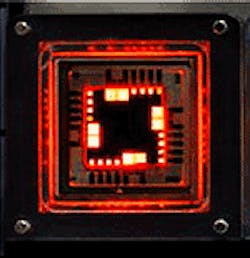Quantum-dot light-emitting diodes (QD LEDs or QLEDs) use nanocrystals called quantum dots as their light-producing material. These dots are excited via electrical charge and emit colors based on their size. In esscence, the larger the dot, the more energy levels and the darker the color hue. The smaller the dot, the greater the energy emitted and the lighter the color hue.
For any type of current or future illumination application, no device name exits the lips faster than light-emitting diodes (LEDs). Every week, some company comes up with a way to make them smaller, brighter, more efficient, and, most importantly, cheaper.
There is also the race between LED types to dominate the solid-state lighting arena. Standard LEDs and organic LEDs (OLEDs) are vying for the lead in the market, in the home, in businesses, and in the press. However, we don’t hear as much about one type of LED that’s starting to rattle a few cages: quantum-dot LEDs (QD LEDs or QLEDs).
Best Of Two Worlds
QLEDs employ semiconductor nanocrystals called quantum dots as their light-emitting material. The nanocrystal architecture is similar to OLEDs, as the material can be formed over large areas and on flexible surfaces. Unlike silicon, an inorganic semiconductor material common to standard LEDs and again similar to OLEDs, quantum dots draw power only when illumination is required. Therefore, QLEDs also address the demand for more power-efficient displays, leading to longer battery life in portable products.
Displays based on quantum dots exhibit some advantages over their OLED counterparts. First, they aren’t as sensitive to humidity. The light-emitting molecules degrade at a much slower rate. And, yes, they can be made quite a bit smaller. Considered by some to be the next-generation display technology, QLEDs are viable contenders for just about every application shared by LEDs and OLEDs, except perhaps general lighting chores for now, which are still the domain of LEDs and the last fluorescent holdouts.
Quite Shady Devices
A unique aspect of quantum dots is the effect the size of the dot has on its color output. In essence, the material can be tuned by changing its size. For a hypothetical example, let’s assume you have a 10-nm dot of a particular material that emits a general shade of red. Trimming the material down to around 5 nm will generate a darker shade or different hue of red.
A partial explanation for this is that large quantum dots have many levels of energy spaced closely together. Decreasing the dot size literally squeezes more energy out of the material because more energy is necessary for excitation in the tighter quarters.
So What’s New?
QD Vision is one of the leaders in QLED research. Though in the early stages of development, its QLEDs suit precision-color applications such as monochrome visible and infrared displays and machine-vision and night-vision systems.
According to the company, QLEDs can meet or surpass National Television System Committee (NTSC) color standards as well as the turn-on voltages at the band-gap voltage of the material. They also can form ultra-thin, transparent, and flexible displays. Probably their biggest advantage is lower manufacturing costs. QD Vision claims it is developing quantum-dot printing techniques with high material utilization to produce low-cost, full-color active-matrix displays and lighting components.
And On The Horizon?
Back in January, QD Vision unveiled what it believes is the highest-resolution quantum-dot-based active matrix display available to date. Designed under the conditions of a Phase II Small Business Innovative Research Program for the U.S. Army, the 15.6-mm diagonal display, which is part of a portable microdisplay imaging system, delivers SVGA resolution: in the realm of 800 by 600 pixels. As the amber monochrome display met or surpassed all program metrics, the company is planning to develop full-color versions.
Last December (2010), LG Display announced that it will be collaborating with QD Vision to develop QLED-based active matrix displays. As mentioned earlier, QLED technology accommodates a richer and a significantly more precise color palette, in near microscopic sizes while supposedly consuming far less power than LEDs or OLEDs. Obviously, LG has set some serious sights on the home television market with this unique technology and, in turn, it will reap the benefits of lower display manufacturing costs.
